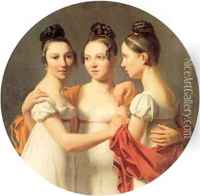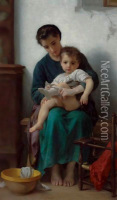Gustave Doyen Paintings
Gustave Doyen was a French painter born on May 10, 1837, in the city of Reims, situated in the northeastern part of France. Doyen was active during a period that saw significant transitions in the world of art, moving from the traditional academic painting that dominated the early part of the 19th century towards the more innovative and experimental approaches that characterized the latter part of the century and the early 20th century. Despite living through the era of Impressionism and Post-Impressionism, Doyen's work remained largely rooted in the academic tradition, although he did incorporate elements of the emerging styles.
Doyen's artistic journey began at a young age, showing an early propensity for drawing and painting. He pursued his art education in Paris, where he studied under influential figures of the French art scene. His work covered a range of subjects, including historical scenes, portraits, and religious themes. Doyen was known for his meticulous attention to detail, a hallmark of academic painting, and his ability to convey emotion and narrative depth in his works.
Throughout his career, Gustave Doyen exhibited his work at various salons and exhibitions, gaining recognition and accolades for his artistic prowess. His paintings were appreciated for their classical beauty, technical skill, and the sense of solemnity and dignity he brought to his subjects. Despite not achieving the same level of fame as some of his contemporaries who were at the forefront of the avant-garde movements, Doyen's work was respected in art circles for its quality and adherence to the high standards of academic art.
Doyen's legacy is that of a skilled artist who navigated the changing tides of the art world with a steadfast commitment to his artistic vision. He continued to paint and exhibit his work until his later years, contributing to the cultural life of France through his traditional yet refined approach to painting. Gustave Doyen passed away on December 25, 1923, leaving behind a body of work that, while perhaps not as widely recognized today, offers a window into the transitional period of art history in which he lived. His paintings continue to be appreciated by art historians and collectors who value the craftsmanship and historical context of 19th-century French art.


